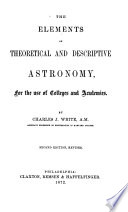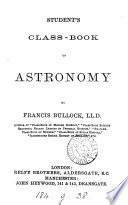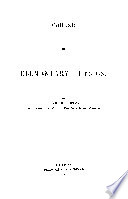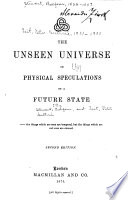 | George Farrer Rodwell - 1871 - 620 pages
...equal times. 3. The squares of the period of complete revolution, or periodic times of any two planets are proportional to the cubes of their mean distances from the sun. (See Central Forces.) KETONE. See Acetone. KILOGRAMMETRE. The French unit used in estimating the mechanical... | |
 | Charles Joyce White - 1872 - 300 pages
...orbit, are proportional to the times. (3.) The squares of the times of revolution of any two planets are proportional to the cubes of their mean distances from the sun. These laws were verified by Newton in his Principia, in a course of mathematical reasoning, the foundation... | |
 | Francis Bullock - 1873 - 240 pages
...moves over Equal Areas in Equal Times ; and (3) that tho Squares of the Periodic Times of the Planets are Proportional to the Cubes of their Mean Distances from the Sun. But these Laws were not universally accepted as the real expression of the phenomena before Newton... | |
 | Charles Robert Cross - 1873 - 182 pages
...planet describes equal areas m equal times. III. The squares of the times of revolution of the planets are proportional to the cubes of their mean distances from the sun. The following is an outline of the course of reasoning followed by Newton. In the first place the proposition... | |
 | Robert Sullivan - 1874 - 502 pages
...understood—36, 69, 95, 144, 490, 900, 1,800, 2,800. The squares of the periodic times of the planets are proportional to the cubes of -their mean distances from the sun. Hence, as the distance of the earth from the sun has been found by the transits of Venus to be about... | |
 | Smithsonian Institution. Board of Regents - 1875 - 428 pages
...over equal areas in equal times ; the third, that the squares of the periodic times of the planets are proportional to the cubes of their mean distances from the sun. The first two laws were discovered by Kepler in the course of a laborious examination of the theory... | |
 | Balfour Stewart, Peter Guthrie Tait - 1875 - 274 pages
...proportional to the times of description ; while the squares of the periodic times of the various planets are proportional to the cubes of their mean distances from the sun. These are Kepler's laws ; they are yet, however, only empirical. We know them to be true, but we cannot... | |
 | 1875 - 588 pages
...sun. This law is expressed as follows : — " The squares of the times of revolution of the planets are proportional .to the cubes of their mean distances from the sun." To give an illustration of this law, we may take the planets Venus and the Earth, whose times of revolution... | |
 | Balfour Stewart - 1875 - 236 pages
...proportional to the times of description ; while the squares of the periodic times of the various planets are proportional to the cubes of their mean distances from the sun. These are Kepler's laws ; they are yet, however, only empirical. We know them to be true, but we cannot... | |
 | 1875 - 806 pages
...times: with respect to any two planets, these laws declare that the squares of their times of revolution about the sun are proportional to the cubes of their mean distances. This last law, as Sir John Herschel has remarked, binds all the planets together and gives to their... | |
| |